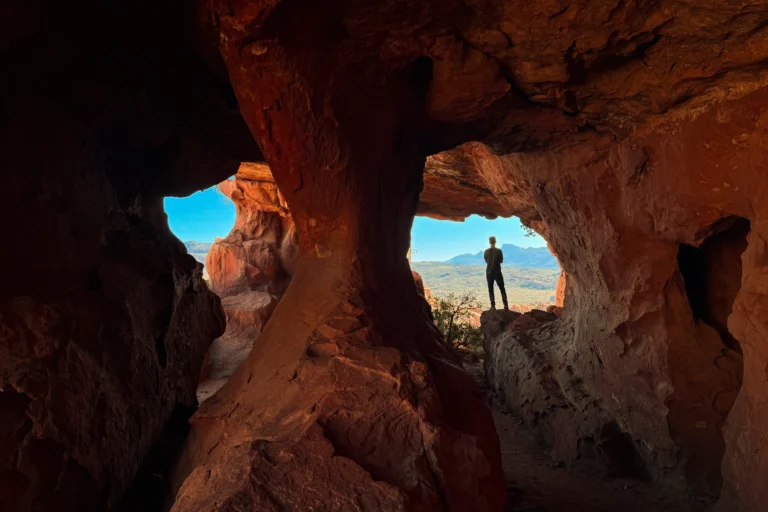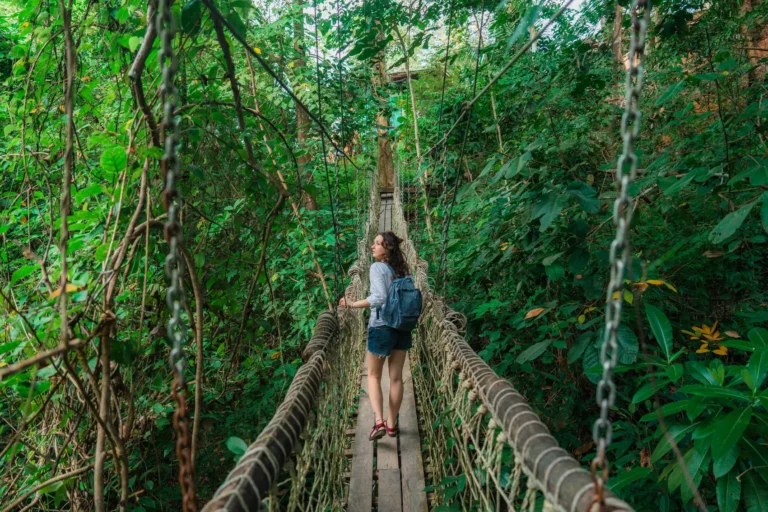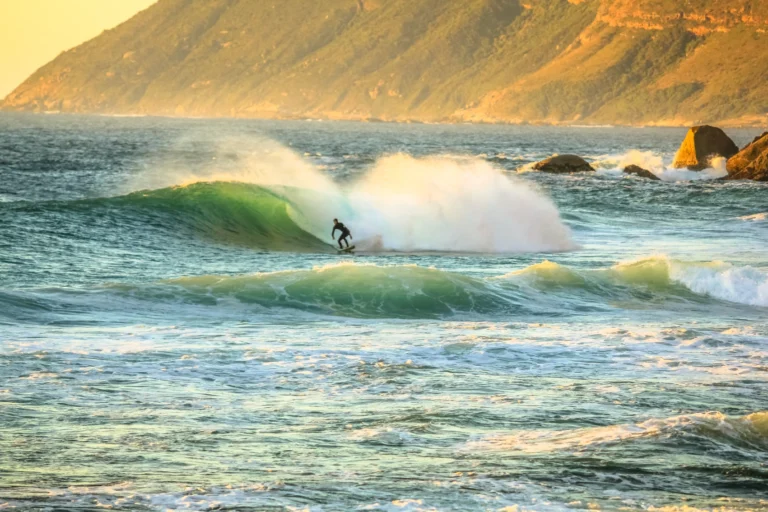
Travellers looking to tackle Africa’s peaks might cast their eyes toward Mount Kilimanjaro, the pinnacle of hikes in Africa. However, hiking in South Africa is like hiking Kili’s younger sibling: smaller trails, but no less beautiful, and still not to be underestimated. With so many incredible hikes in South Africa to choose from, deciding which routes to add to your itinerary is no easy feat. Here’s a sampling of South Africa’s beautiful treks and trails.
Hiking Lion’s Head
If you have only 24 hours in Cape Town and you want to plan one hike, then make it Lion’s Head. Hiking up to Lion’s Head for sunset is one of the best ways to spend an evening in Cape Town. From the top of Lion’s Head, you get a 360-degree view of the city framed by Table Mountain, Camps Bay, the Atlantic seaboard, and the Indian Ocean in the distance. As well as being a relatively short hike at 4.5km (2.7 mi), it’s also versatile, with two trails of varying degrees of difficulty (although both do require an adventurous spirit!).
On both trails, hikers need to traverse steep sections, climb ladders, hoist themselves over boulders, and haul themselves up rocky outcrops in some sections. For daring hikers, there is a shortcut that involves climbing staples lodged into the cliffside, which is not suitable for those with a fear of heights. Plenty of guide ropes and chains help less-experienced hikers.
Experience it for yourself on: Cape Town, Kruger & Zimbabwe
Platteklip Gorge to Upper Cable Station
Table Mountain is the most recognizable natural icon in Cape Town. It sits like a protective parent behind the city, where its rocky pinnacle seamlessly slopes into verdant folds of limestone hills and healthy fynbos vegetation on all sides. No trip to Cape Town is complete without hiking to the top, but with 380 trails offering something special and unique, it’s not easy to pick which is best.
For your first experience hiking Table Mountain, Platteklip Gorge to Upper Cable Station is the recommended route because it’s quick and the least challenging of all hikes. Spoiler alert: all hikes up Table Mountain are challenging! This 2.9km (1.8 mi) vertical hike has an elevation of 713m, with some knee-high steps and boulders to scramble over. As you ascend, the trail takes you deep into the jagged gorge, surrounding you with steep quartzitic sandstone faces, before reaching the cloudy peak.

Experience it for yourself on: Best of South Africa
Kasteelspoort Trail to Diving Board
If you’d prefer a longer, more challenging, and arguably more beautiful trail up Table Mountain, head around the east side of the mountain to hike the 4.7km (2.9 mi) out-and-back Kasteelspoort Trail up to the Diving Board rock formation. You can also easily extend this hike to the Upper Cable Station, adding on an extra hour. From there, you can take the cable car back down instead of hiking back the way you came. The trail is steep, with an elevation gain of 576m (1,890 ft), and some scrambling is involved in the wooded ravine at the top. Your hamstrings will be screaming by the end, but it’s worth it for the incredible views. Because this hike takes you up Table Mountain’s eastern side, it offers panoramic views of Camps Bay and Lion’s Head in the distance.
Experience it for yourself on: Cape Town to Victoria Falls Overland Safari
Rainbow Gorge Trail, Cathedral Peak
Rainbow Gorge in the Drakensberg Mountains is a stunning 5.6km (3.4 mi) out-and-back trail through a craggy gorge, filled with a flourishing yellowwood forest and gently cascading waterfalls. The gorge gets its name from the sunlight reflecting off the waterfalls, which creates a series of rainbows during golden hour. This trail is also known for its serene atmosphere, stunning vistas, and abundant bird life. Even during peak tourist season, this hike offers solitude. The first section is steep and has a few ladders to climb and boulders to scramble, but the remainder of the hike is gradual and worth the effort. As you traverse through the gorge, you follow the trail next to the Ndumeni River, where there are plenty of rock pools and swimming holes to bathe in, so be sure to pack your swimsuit!
Wolfberg Arch via Wolfberg Cracks
The trail to the Wolfberg Arch in the Cederberg Mountains is the adventurous hiker’s dream. This 11.9km (7.3 mi) trek takes you through a narrow, rugged gorge known as the Wolfberg Cracks, or simply “The Crack,” before reaching the Wolfberg Arch, a rock archway made from natural erosion over thousands of years. The hike has some light scrambling and boulders to hoist yourself over (and under), and the canyon can get reasonably narrow in places, so it’s not suitable for those with claustrophobia. However, those fascinated by rock formations get an up-close view of the enormous cracks and crevices of this ravine. The Cederberg Mountains are accessible year-round, so no matter what time of year you visit South Africa, you can enjoy a hike in this rugged mountain range. A hiking permit is required.

Otter Trail, Tsitsikamma National Park
Perhaps the most famous multi-day hike in South Africa is the 42km (26 mi) Otter Trail, which begins at Storms River Mouth Rest Camp in Tsitsikamma National Park and ends in Nature’s Valley. The trail hugs the Garden Route coastline, crossing over the untamed coastal plateaus and atop sheer cliffs that showcase the ferocious power of the surf hitting South Africa’s beaches. It’s also where you can spot the trail’s namesake, the sea otter, a nocturnal and shy animal that is often seen at dawn and dusk during its hunt. The best time to hike is from November to January, when southern right whales and humpback whales are on their annual migration.
Experience it for yourself on: Ultimate South Africa
Point Trail, Robberg Nature Reserve
Another hiking trail on the Garden Route known for its wildlife is the Point Trail in Robberg Nature Reserve, located in Plettenberg Bay. The 7.7km (4.7 mi) Point Trail takes you around a headland, where a large colony of Cape fur seals can be seen sunning on the rocks or swimming in the kelp forests in the waters below. You might even spot a mighty great white shark, too. It’s estimated that about 6,000 seals live in the reserve, and on the Point Trail, you get a bird’s-eye view of hundreds of them from the headland.
Experience it for yourself on: South Africa: Cape Town & The Garden Route
Tugela Falls Hike to Sentinel Peak
Tugela Falls is the second-tallest waterfall in the world and is only accessible by hiking. Tugela Falls is unique in that it’s a series of five falls merged into one, plunging for a total of 948m (3,110 ft). The hike to Sentinel Peak, which marks the top of the falls, gives you several viewpoints of Tugela Falls’ five leaps, as well as providing a thrilling venture to the peak. This 11.7km (7.2 mi) hike is well known for its chain ladders up an imposing basalt wall known as the Amphitheatre. If you’re afraid of heights, this section may be difficult. However, if you love to put yourself out of your comfort zone, hiking this trail promises to be a heart-pumping thrill.

Experience it for yourself on: Active South Africa: Cape Town, Kruger & Tugela Falls
Leopard Trail, Baviaanskloof Wilderness
Another popular multi-day South Africa hike is the 39.5km (24.5 mi) Leopard Trail, a “slackpacking” hike around the Baviaanskloof Wilderness Area. The trail takes you through the valley of the Kouga and Baviaan foothills, past kloofs (ravines) filled with refreshing pools to swim in. What’s unique about this trail is that only 12 hikers are allowed on the trail at a time. This is for the safety of the hikers because this trail passes through the habitat of the elusive leopard. Although leopards roam in this area, sightings are rare because they are shy. However, you might encounter monkeys, baboons, several species of antelope, zebra, buffalo, and other fascinating South Africa wildlife.
Whale Trail, De Hoop Nature Reserve
The 55.7km (34.6 mi) Whale Trail is a popular route for hikers interested in whale sightings (between June and November). Hugging the banks of the Southwest Cape, this floral trail sits next to the largest marine protected area in South Africa, extending from Potberg to Koppie Alleen. The nature reserve overlooks the breeding grounds for the southern right whale, best seen from the dunes at Koppie Alleen. About 120 whales return to this spot each year to breed. The Whale Trail is known for its unspoiled landscape of high dunes, healthy fynbos bonsai, and Port Jackson willow trees, which open up to offer striking views of the ocean.
Coffee Bay to Hole in the Wall
The Hole in the Wall is a striking natural archway formed by erosion from crashing waves pounding against the Ecca shale and sandstone over millions of years. It’s located off the coast of Coffee Bay in South Africa’s Eastern Cape. To view this natural phenomenon, an 8.4km (5.2 mi) point-to-point hike starts from Coffee Bay, followed by a shuttle bus back over a poorly maintained gravel road. As well as the rock formation, hikers can glimpse expansive views of the Indian Ocean. From June to December, it’s possible to see whales and dolphins frolicking in the waters.
Paradyskloof Waterfall Hike
The Paradyskloof Waterfall Hike is a beautiful yet strenuous walk in South Africa’s premier wine region, Stellenbosch. The 5km (3.1 mi) Paradyskloof hike takes you on a winding trail through a ravine into the Hottentots Holland Mountains, where you will be surrounded by the fresh aromas of pine trees and fynbos flowers before reaching a quiet rest area under a waterfall. A few areas require some scrambling, and there are a few river crossings, but generally, the trail is moderately challenging and has only 269m (882.5 ft) of elevation change.


